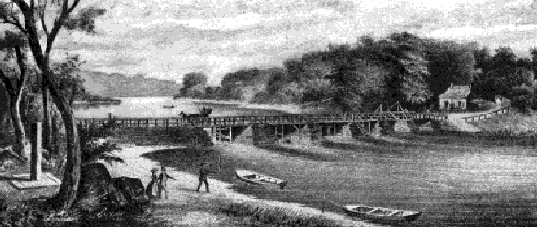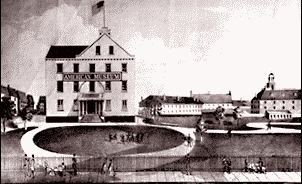Chapter III excerpts: 1816 - Jacob Radcliffe, Mayor (Continued)

|
|
Malcolm's Dam and continuation of road from 155th Street, Harlem River.
|
. . . . Of the change in social, domestic, and business customs
and conveniences, from 1816 to the present day, none but one who has experienced
it can give a proper estimate.
|
Background note:
|
|
An early 19th century illustration depicts John Scudder's American Museum sign prominently displayed on the New York Institution for the Promotion of the Arts and Sciences building, the old municipal almshouse that had been converted into the city's first non-profit cultural center. It was situated on Chambers St. behind City Hall seen in the background.
|

|
The New York Institution or
Almhouse and part of jail.
|
At the earlier date, bathrooms were totally
wanting in private houses and hotels, and there was but one public bath,
that of Stoppani, in Chambers Street. . . .
. . . .
The employment of ice for any purpose but for making icecream
was unknown. . . . Even the icecream (water ices were unheard of)
was furnished only by Mrs. Usher, in Broadway, where the New York Hotel
lately stood; and by John H. Contoit of the New York Garden, in
1801 at 39 Greenwich Street, in 1802 at 253 Broadway, and in 1806, and
for many years after, at 355 Broadway, between Leonard and Franklin streets. . . .
. . . The public racecourse was on Hempstead
Plains, and known as the New Market. The principal or noted restaurants
were De Cousse's, in Reade Street, under Washington Hall; Ainslie's in
Broadway, between Duane and Anthony streets; and Lovejoy's, Broadway, corner of Anthony Street (Worth). . . .

|
|
The career of John Jay, for whom CUNY's College of Criminal Justice is named, included service as the state's and the nation's first Chief Justice as well as NYS Governor. A leading Federalist advocate for abolition, he served as the president of both the American Bible Society and the New York Manumission Society, the later founded in 1785 with its primary focus on ending slavery in New York. By 1816, slaves were a dwindling minority among African New Yorkers. So Haswell's comment here that "this year [1816] was organized, under the presidency of Cadwallader D. Colden, the Manumission Society to advance the freedom of slaves at the South" might better be understood as his reporting on the society's enlargement of focus to include ending the practice in the South.
|
At this time the apprentice system was in full operation;
boys desiring to acquire a trade were apprenticed to the employer until
they were twentyone years of age, and in most cases, as of old, they
resided in the house of the employer and consequently were subjected to
his discipline, not only in deportment but as to hours of retiring and
other habits of life. Workmen, that is, all artisans and laborers, whether
men or apprentices, were employed and paid according to the work performed
by them, and the estimate of their capacity. Employers engaged or discharged whomsoever they saw fit to, and although there were not any societies that assumed to fix the wages of workmen, the rate of wages for the different grades of work and classes of workmen was well known and as well observed and conceded. . . . .
The law of imprisonment for debt was in force at this
time, and the jail for this noncriminal class becoming overcrowded,
certain of them were allowed freedom within fixed limits outside of the
jail, or " jail liberties," as they were termed, which were then
confined to the territory below Anthony on the north and west sides and
somewhere about its adjoining street on the east side; notices of the limits being painted on the corners.
. . ..
Notable events in this year were the completion of Macomb's
Dam, at the site of the present bridge, which soon became a justly favorite
spot for fishing, the opening of Eighth and Ninth avenues and First and
Thirteenth streets, the extension of Hudson Street from Laight Street to
Greenwich Avenue, and of Franklin Street. In this year was organized, under
the presidency of Cadwallader D. Colden, the Manumission Society to advance
the freedom of slaves at the South. . . .
The American Museum of John Scudder, first opened in 1810
at 21 Chatham Street, removed in this year to the west end of the building of the New York Institution, on Chambers Street.

|
|
The society years ago moved from its original site and is now at 1865 Broadway and 61st St.
|
The block bounded by Centre, Leonard, Elm, and Franklin
streets was occupied by the city, and known as the Corporation Yard, where
the fireengine and ladder trucks were built and equipped, and light
work was done connected with repairs of public buildings, coffins for paupers, etc.
The American Bible Society was organized in May of this year, and its first publication was issued, in 1819, from No. 20 Slote Lane . . . .
At this period there were but ten wards in the city. Arson
was punishable with death. Slavery existed, both slaves and their "times" were advertised in daily papers. . . .
|





